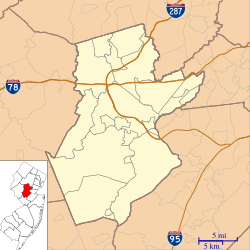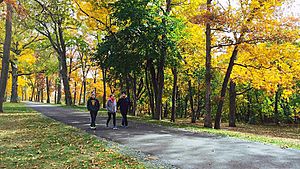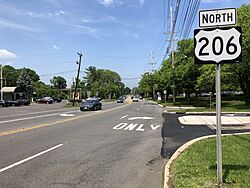Montgomery Township, New Jersey facts for kids
Quick facts for kids
Montgomery Township, New Jersey
|
||
|---|---|---|
|
Township
|
||

|
||
|
||
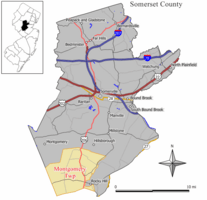
Location of Montgomery Township in Somerset County highlighted in yellow (right). Inset map: Location of Somerset County in New Jersey highlighted in black (left).
|
||
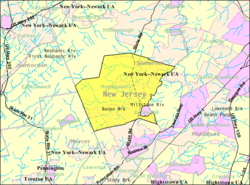
Census Bureau map of Montgomery Township, New Jersey
|
||
| Country | ||
| State | ||
| County | ||
| Incorporated | February 21, 1798 | |
| Named for | Colonel Richard Montgomery | |
| Government | ||
| • Type | Township | |
| • Body | Township Committee | |
| Area | ||
| • Total | 32.47 sq mi (84.11 km2) | |
| • Land | 32.30 sq mi (83.66 km2) | |
| • Water | 0.17 sq mi (0.45 km2) 0.54% | |
| Area rank | 75th of 565 in state 3rd of 21 in county |
|
| Elevation | 98 ft (30 m) | |
| Population
(2020)
|
||
| • Total | 23,690 | |
| • Estimate
(2023)
|
23,719 | |
| • Rank | 113th of 565 in state 5th of 21 in county |
|
| • Density | 733.4/sq mi (283.2/km2) | |
| • Density rank | 415th of 565 in state 16th of 21 in county |
|
| Time zone | UTC−05:00 (Eastern (EST)) | |
| • Summer (DST) | UTC−04:00 (Eastern (EDT)) | |
| ZIP Code | ||
| Area code(s) | 609, 908 | |
| FIPS code | 3403547580 | |
| GNIS feature ID | 0882168 | |
Montgomery Township is a community located in southern Somerset County, in the central part of New Jersey. It is part of the larger New York Metropolitan Area. In 2020, about 23,690 people lived here. This was an increase of over 1,400 people since 2010.
Montgomery Township became an official township on February 21, 1798. It was one of the first 104 townships created in New Jersey. Over time, some parts of the township were separated to form other towns like Princeton and Rocky Hill. The township was named after General Richard Montgomery, a hero who died fighting in the Battle of Quebec during the American Revolution.
Montgomery Township is known for being one of the wealthiest communities in New Jersey.
Contents
History of Montgomery Township
Early Inhabitants and European Settlers
Long before Europeans arrived, the Lenni Lenape tribal groups lived in the area that is now Montgomery Township for about 20,000 years. Today, only a small number of Native Americans live in the township.
The first Europeans to own land here were not settlers themselves. They were people who bought large areas of land and then sold smaller pieces to farmers. Many of these early landowners and settlers were of Dutch descent, coming from the New Amsterdam area (which later became New York). The area was first called the Western Precinct of Somerset County.
Farming and Early Community Life
Most of the land in Montgomery Township is flat and good for farming. Early settlers practiced "subsistence farming," meaning they grew most of what they needed to live. Farms often had vegetable gardens, orchards, and fields for grain. They also had forests for wood.
Mills were built along streams like Rock Brook to saw lumber or grind grain. Early communities grew around important spots like intersections, where churches, schools, stores, and taverns were built. Schools were placed so that no child had to walk more than 2 miles to get to one.
The first church in Harlingen was built around 1750. Services were often held in Dutch until about 1800. The Blawenburg church, which came from the Harlingen church, was built quickly in just three days in 1830.
Transportation Changes and Growth
During the American Revolution, both British and American soldiers marched and fought in the township. In the years that followed, transportation improved.
- The Georgetown and Franklin Turnpike (now Route 518) was built in the 1820s.
- The Delaware and Raritan Canal was dug in 1834, helping move goods.
- Railroads arrived in 1875, with stations at Skillman, Harlingen, and Belle Mead.
- In the early 1900s, cars, electricity, and telephones brought even more changes.
These changes led to larger central schools replacing small one-room schoolhouses. Many small crossroad communities, like Skillman and Dutchtown, became less important as centers of daily life, but their names still mark roads and areas.
Modern Development
Farming continued to change over time. By the late 1800s, farms started to focus on specific products like dairy, poultry, or fruit. As land became more valuable, farming became less profitable.
After World War II, many farms were replaced by new housing developments, shopping centers, and business parks. For example, a facility for treating epilepsy was built on farmland in 1898, which later became the North Princeton Developmental Center.
Today, Montgomery Township has grown rapidly, especially since the 1990s. There is a strong effort to protect open spaces and manage new development.
Geography of Montgomery Township
Montgomery Township covers about 32.47 square miles (84.11 square kilometers). Most of this area is land, with a small amount of water.
Communities and Neighbors
Several smaller communities are located within Montgomery Township. These include:
Other smaller places in the township are Amwell, Bridgepoint, Dutchtown, Fairview, Plainville, Rocky Hill, Stoutsburg, and Zion.
Montgomery Township shares borders with other towns and counties:
- In Somerset County: Franklin Township, Hillsborough Township, and Rocky Hill.
- In Hunterdon County: East Amwell Township.
- In Mercer County: Hopewell Township and Princeton.
The township has its own post offices in Belle Mead, Skillman, and Blawenburg. Some parts of the township also use the Princeton post office.
Local Environment
The natural plant life in Montgomery Township would mostly be Appalachian Oak trees and Eastern Hardwood Forests. This means the area is naturally home to many types of oak trees and other trees that lose their leaves in the fall.
Population and People
Montgomery Township has seen a lot of growth in its population over the years.
- In 1790, there were 1,875 people.
- By 1950, the population was 3,819.
- In 2000, it jumped to 17,481.
- By 2020, the population reached 23,690.
This shows that many people have chosen to move to Montgomery Township, especially in recent decades.
In 2010, the population was 22,254. About 30.8% of the people were under 18 years old. The average age was 40.8 years.
Parks and Recreation
Skillman Village
In 2007, Montgomery Township bought a large piece of land called the North Princeton Developmental Center. This land, about 256 acres, used to be a facility for people with epilepsy and later a psychiatric care center. It had many buildings, but most were old and unsafe.
The township planned to develop the land into a "Town Square" with homes and businesses. However, no developers were interested.
Skillman Park
Later, in 2010, Somerset County bought most of the land to create a large public park. This park is now called Skillman Park and covers 247 acres. It is a "passive-use park," meaning it's for activities like walking, jogging, and enjoying nature. Skillman Park officially opened in April 2015 and is maintained by the Somerset County Parks Department.
Education in Montgomery Township
The Montgomery Township School District serves students from pre-kindergarten through 12th grade. It includes students from both Montgomery Township and Rocky Hill. In the 2022-2023 school year, there were about 4,611 students and 403 teachers in the district.
The district has five schools:
- Orchard Hill Elementary School (PreK-2)
- Village Elementary School (grades 3-4)
- Montgomery Lower Middle School (grades 5-6)
- Montgomery Upper Middle School (grades 7-8)
- Montgomery High School (grades 9-12)
The current Montgomery High School opened in 2005. It has an indoor pool and an outdoor turf field. In 2008, the high school added a solar panel field to help save energy.
The school district grew very quickly between 1992 and 2005, with student numbers tripling. However, growth has slowed down since then. Montgomery High School has often been ranked among the top public high schools in New Jersey.
Transportation and Healthcare
Roads and Travel
Montgomery Township has many miles of roads. The main road that runs through the township is U.S. Route 206. Another important county road is CR 518. Larger highways like Interstate 287 and Interstate 295 are also nearby.
For public transportation, NJ Transit offers local bus service on route 605. The Princeton Airport is also located within the township.
Healthcare Services
For medical care, Penn Medicine Princeton Medical Center is a large hospital located in nearby Plainsboro Township. It has 355 beds and serves the greater Princeton area. Other hospitals like Robert Wood Johnson University Hospital and Saint Peter's University Hospital are also accessible in nearby New Brunswick and Somerville.
Notable People from Montgomery Township
Many interesting people have lived in or are connected to Montgomery Township:
- Wade Baldwin IV (born 1996), a professional basketball player.
- Ben Bernanke (born 1953), who used to be the head of the Federal Reserve. He also served on the Montgomery Township Board of Education.
- Yvonne Brill (1924–2013), a brilliant rocket scientist.
- Mike Ford (born 1992), a baseball player who played for the New York Yankees.
- Sadaf Jaffer (born 1983), a politician who was once the Mayor of Montgomery Township.
- John Milhiser (born 1981), an actor and comedian known for being on Saturday Night Live.
- Upton Sinclair (1878–1968), a famous writer who lived in the township when he wrote his well-known book, The Jungle.
- Tom Verducci (born 1960), a sportswriter for Sports Illustrated.
See also
 In Spanish: Municipio de Montgomery (Nueva Jersey) para niños
In Spanish: Municipio de Montgomery (Nueva Jersey) para niños



